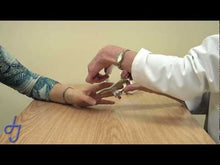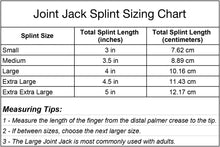Flexion deformities of the PIP joints of the fingers are a common problem in hand rehabilitation. Static progressive splinting is effective in overcoming these deformities. The Joint Jack® provides this steady force with infinite control and adjustability.
The Joint Jack® is made of mild steel for adaptation to all finger positions. The drive mechanism consists of a screw and strap permanently attached yet capable of being placed anywhere on the bridge of the splint. The tension on the strap is progressed by tightening the screw. It is available in five sizes. The large size is most frequently used.
Indications for use may include:
• Dupuytren’s contracture post surgery or Xiaflex
• PIP joint stiffness
• Trigger finger release (stenosing tenosynovitis or STS)
Application of the Joint Jack®
We highly recommend having the Joint Jack® custom fitted by a licensed Physical, Occupational, or Hand Therapist.
Apply the Joint Jack® for one hour two or three times a day, or if it is to be worn all night, an hour before retiring.
Step 1: Bend the metal extension bar of the splint so the strap and screw fit directly at the PIP joint. Be sure the screw is directly perpendicular (at a 90º angle) to the metal plate.
Step 2: Adjust the ends with pliers for a comfortable/contoured fit in the palm and to avoid pressure at the tip. The pressure should be more on the volar plate of the DIP joint than on the tip of the finger.
Step 3: With the screw backed out, tighten the strap. A pen mark can be used to establish a consistent starting point.
Step 4: Gradually tighten the screw so that there is steady pressure, but not pain. There is rapid, early gain that must be overcome for each application. Because of this "rapid gain phase," the successful use of the Joint Jack® follows applications of one hour or more. During the course of the hour, continue to gradually tighten the screw to maintain steady pressure. Be careful not to tighten the screw too aggressively which may cause pain.
Step 5: Should the screw become fully tightened, it is then backed off completely, the strap is taken up as much as possible, and the screw turning is resumed.
If the splint is to be worn at night, a circumferential piece of tape will hold it in place, or use a velcro strap with self-adhesive hook placed on the proximal end of the splint. The screw can be loosened slightly for sleeping.
Variations:
The Joint Jack® can also be modified to use on the interphalangeal joint of the thumb, or the DIP joint of a finger. To apply, the strap and screw are simply placed at the level of the joint.






